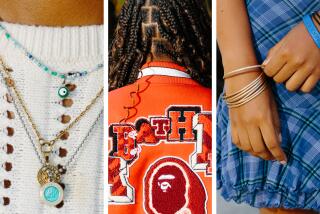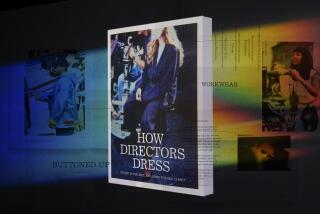Letting Loose on Friday : A workday without ties, pantyhose or pumps? It’s true. Businesses are easing dress codes in an attempt to boost morale. Even the conservative corridors of banks and law firms are joining in.
- Share via
It is Friday, which means office manager Kim Dixon will take only 15 minutes to dress for success. Instead of crafting a French twist, she will toss on a baseball cap. Instead of sifting through silk separates and suede shoes, she will whip on jeans, an oversize T-shirt and cowboy boots.
For Dixon and millions of others nationwide, this is casual Friday. Inspired by the think-tank attire of the Silicon Valley, where dressing down has long been the norm, it’s a day in which firms try to boost morale by releasing employees from suits and ties, pantyhose and pumps. A familiar sight in advertising agencies and other creative havens, casual clothes are now invading the conservative corridors of banks and law firms, if only once a month. Benefits range from a relaxed mental state to a nice savings on clothing and dry-cleaning bills, employees say.
For the past three years, Fridays at Creative Design Consultants in Costa Mesa have been more comfortable and productive because of the company’s casual day policy, creative director Julie Ann Macias says. “You can notice a difference because everyone is getting ready for the weekend. Maybe they slept in that day because they could dress quicker in their casual clothes. But once they arrive at work, everyone’s working hard to finish up their work and get things done so they can leave.”
The company’s employees trade in their normal business attire--jackets with slacks or dresses with hose--for Friday wear--dressy jeans and boots or Bermuda shorts and huaraches. Hair that’s neatly pulled back to avoid distraction at client presentations during the first four days of the week is hidden under straw hats or baseball caps.
The guidelines at Creative Design Consultants? “Casual but clean,” Macias says.
The comfort level varies from office to office--as does the frequency of casual days. In some companies, jeans are fine; in others, they are taboo. Most declare beachwear off limits and promote classy weekend attire such as khaki pants, Bermuda shorts, polo shirts.
“You still have to have a professional appearance in case you run into the president in the hall,” explains James Boyd, assistant manager of graphics for Hilton Hotels Corp. in Beverly Hills. On the company’s monthly casual day, Boyd says, “the president sets the tone,” typically wearing a “nice” sweater or polo shirt, slacks and loafers.
Boyd’s enthusiasm starts to build on Thursday night, when, he says, “it’s a relief to know you can roll out of bed in the morning and roll into your Cole Haans.” With the loafers, he usually wears a chambray shirt and loose-fitting jeans. And his Friday comfort doesn’t stop there. Minus a conservative suit, tie and shirt, Boyd says: “I don’t have the dry-cleaning bill adding up in the back of my mind.”
Dixon, office manager of Clein + White, a small public relations firm in West Hollywood, says weekly dress-down days save her more than $600 a year--in dry-cleaning bills and in “not buying that extra outfit, that extra pair of slacks.”
But the day isn’t a given. If a client is expected in the office, Dixon says, “we choose as a group to dress a bit better, even though we could come in casually.”
In some firms, there isn’t a choice. A client’s scheduled visit triggers the alert for business attire, an alert delivered by memo, phone or what one employee jokingly calls “a visit from the fashion police.”
At Creative Design Consultants, casual day is canceled if a client is coming in. “Image is important in our business, and our image is reflected in our attire,” Macias says. “But we try to avoid Friday client presentations if we can.”
At Langberg, Leslie, Mann & Gabriel, a Century City law firm, there is a different approach. To greet new clients, senior partner Barry Langberg says he wears a business suit. But his colleagues aren’t expected to go along, and Langberg tells his visitors “up-front that casual day is a tradition in the office.”
When a couple of lawyers quietly started dressing down a few years ago, Langberg was less than thrilled. “I thought we should dress more formally,” he says. “I thought if clients came in, it wouldn’t be the right appearance.”
Now, he wears jeans and so do longtime clients “who have taken up the tradition.” But Langberg still takes a ribbing over a memo in which he attempted to define the boundaries of casual. He specified “no beachwear” without giving any examples. “I keep telling them ‘I’ll know it when I see it.’ ”
Some dress-down edicts just won’t die. Earlier this year, publisher HarperCollins formally introduced a casual day for its New York staff--only to find excerpts from its memo and an employee’s letter in a Publishers Weekly article headlined, “Are Kilts Okay?”
The employee complained that the list of “unacceptable items such as sweat suits, torn jeans and tank tops . . . left hundreds of New York staffers openly pondering whether nose rings, tattoos and men with earrings are still OK since they--along with swimsuits, halter tops and micro-miniskirts--were not included on the company’s inappropriate attire list.”
At another New York publishing house, Oxford University Press, slippers would be on the “no” list. Andrew Albanese, an assistant editor, says a memo was issued after “one individual wore a halter top and another wore slippers and looked as if he just rolled out of bed.”
Employees are allowed to “loosen up on Friday, but no one is swinging from the chandeliers,” Albanese says, adding: “You still have to be somewhat concerned about your appearance, because it is so ingrained within you and because you don’t want to come into work looking like a slob. (The impression) might carry over to other days.”
John T. Molloy, author of “Dress for Success” and a leading advocate of the business “uniform,” is busy changing the rules to accommodate casual Friday. “A lot of my corporate clients have chosen to go in that direction,” he says. “The interesting thing is, when you put it into effect, all these wonderful reports come flying through. Six months later, there are complaints.”
The owner of a small company whose casual day backfired brought Molloy in. “He wanted some guidelines. He wore a sport jacket, but the young guys came in jeans and sneakers. And one woman was wearing leggings like a ballet dancer. This blew him out of the water,” Molloy says. The final list ruled out jeans, leggings, very short skirts and revealing blouses.
Dressing down “is a very tricky deal for women,” Molloy says. “They had a uniform--a jacket of some sort over a dress or a skirt. It’s conservative, not too flashy. Once you say casual the rules are gone. There are more chances of making a mistake.”
Anne Pringle, pension coordinator for Hilton Hotels, agrees. “Everyone loves the day,” she says. “But I think all the women are commenting on the problem of what to wear, just because women have a wide variety of options. I think women have a more difficult time deciding what is casual and what is professional at the same time.”
Susan Meisinger, vice president of the Society for Human Resource Management in Alexandria, Va., identifies with the quandary. After the group, which represents 54,000 personnel professionals, polled members and found 67% had a casual Friday, it established its own.
“Initially, I had to go home and assess the closet to find something that met the criteria,” Meisinger says. “Something that was formal enough for an executive in the organization, but informal enough not to be considered my normal business wear. And not as informal as something I would wear on the weekend.
“I got to go shopping. It wasn’t that terrible,” she quips. “As a practical matter, I use the clothes for informal social functions.” Although she could wear jeans, Meisinger prefers slacks, Oxford-cloth shirts and silk print blouses. More than 20 years in the workplace has influenced her idea of dressing down.
It is a similar situation for Lee Dawson, a vice president with Wells Fargo Bank in Los Angeles. “To show you how much things have changed,” he says, “over 24 years ago, when I was a trainee, I came to work in a blue dress shirt and the manager sent me home to change to a white one.” Now his department observes casual Friday and he wears something “conservative,” such as a sport shirt, khaki slacks and loafers or Rockport shoes.
Initially, surrounded by suits on his Metrolink commute, he said he was a little uncomfortable. “I felt I wasn’t properly dressed. When we first started doing this, I found myself telling people: ‘Oh, it’s casual day. That’s why I’m dressed like this.’ I don’t do that anymore.”
At the Sullivan Cos., insurance brokers with offices in Pasadena and Los Angeles, casual Friday is decided department by department, depending on how much interaction employees have with clients. The day was offered, as in many companies, “as a kind of morale boost in economic down times,” says John Bigelow, vice president of administration.
He can’t participate, but his ride-share partner, Kami Carpenter, can. “When I get in the car, my joy is it’s Friday,” says Bigelow. “Hers is that she can dress casually.”
Carpenter, an underwriting assistant, feels “a lot more productive” in jeans and tennis shoes. “It’s easier to do things. And the general mood is a lot better too, a lot more relaxed. I’m a happier person on Friday. It’s just a lot of different things. If you file, you don’t have to worry about snagging your nylons. If you want to go for a walk, you don’t have to change your shoes.”
Designer Macias agrees. “I love dressing casually, because I can lay out fabrics on the floor and not worry about collecting lint, or I can go to the marketing support area where all the presentation boards are made and there’s glue and other stuff on the tables and I can work there and lay out the blueprints and fabrics and area rugs and get a feel for the (interior design) project. I can keep things moving without sitting behind my desk all the time.”
As yet, casual-Friday clothing isn’t featured in stores. But DNR, a menswear trade publication, recently ran a four-part series titled “FridayWear,” with photographs of men on New York streets in dapper sportswear. Or as the publication put it: “New York Dudes in Their Friday Duds.”
A lot of the duds looked like Levi’s. Maker Levi Strauss & Co. promotes a national “Casual Day for United Cerebral Palsy,” one of many fund-raisers in which employees are charged for the privilege of dressing down. And within the company, business casual is defined as “clothes that allow you to feel professional but allow you to feel unrestricted,” marketing specialist Brad Williams says.
But lawyer Barry Langberg sees more to the day than comfortable clothing. “Anything people share is good for morale,” he says. “If we had a formal day where people had to dress up in tuxedos, that would probably have the same effect--although it would be more of a pain in the neck.”
More to Read
Inside the business of entertainment
The Wide Shot brings you news, analysis and insights on everything from streaming wars to production — and what it all means for the future.
You may occasionally receive promotional content from the Los Angeles Times.










